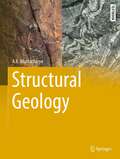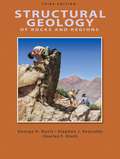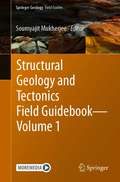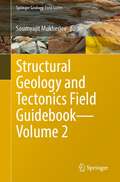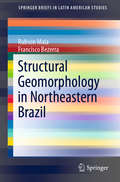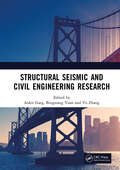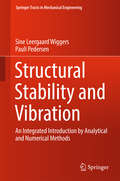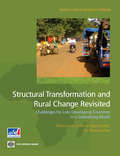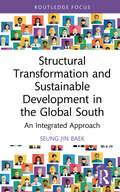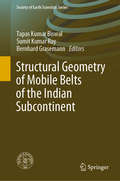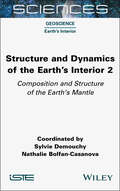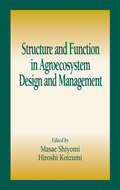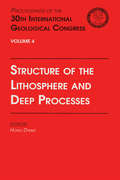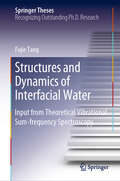- Table View
- List View
Structural Geology (Springer Textbooks in Earth Sciences, Geography and Environment)
by A.R. BhattacharyaThis textbook is a complete, up-to-date, and highly illustrated account of Structural Geology for students and professionals, and includes fundamentals of the subject with field and practical aspects. The book aims to be highly reader-friendly, containing simple language and brief introductions and summaries for each topic presented, and can be used both to refresh overall knowledge of the subject as well as to develop models for engineering projects in any area or region. The book is presented in 20 chapters and divided into 3 parts: (A) Fundamental Concepts, (B) Structures: Geometry and Genesis, and (C) Wider Perspectives. For the first time as full chapters in a textbook, the book discusses several modern field-related applications in Structural Geology, including shear-sense indicators, and deformation and metamorphism. Also uniquely included are colored photographs, side by side with line diagrams, of key deformation structures not seen in other books before now. Boxes in each chapter expand the horizons of the reader on the subject matter of the chapter. Questions at the end of each chapter, and detailed significance of the key structures, provide a better grasping to students. Glossary at the end of the book is a refreshing aspect for the readers. Though written primarily for undergraduate and graduate students, the text will also be of use to specialists and practitioners in engineering geology, petrology (igneous, sedimentary, and metamorphic), economic geology, groundwater geology, petroleum geology, and geophysics, and will appeal to beginners with no preliminary knowledge of the subject.
Structural Geology Algorithms
by Richard W. Allmendinger Donald M. Fisher Nestor CardozoState-of-the-art analysis of geological structures has become increasingly quantitative but traditionally, graphical methods are used in teaching. This innovative lab book provides a unified methodology for problem-solving in structural geology using linear algebra and computation. Assuming only limited mathematical training, the book begins with classic orientation problems and progresses to more fundamental topics of stress, strain and error propagation. It introduces linear algebra methods as the foundation for understanding vectors and tensors, and demonstrates the application of geometry and kinematics in geoscience without requiring students to take a supplementary mathematics course. All algorithms are illustrated with a suite of online MATLAB functions, allowing users to modify the code to solve their own structural problems. Containing 20 worked examples and over 60 exercises, this is the ideal lab book for advanced undergraduates or beginning graduate students. It will also provide professional structural geologists with a valuable reference and refresher for calculations.
Structural Geology Of Rocks And Regions
by George H. Davis Stephen J. Reynolds Charles F. KluthRelates the physical and geometric elegance of geologic structures within the Earth's crust and the ways in which these structures reflect the nature and origin of crystal deformation through time. The main thrust is on applications in regional tectonics, exploration geology, active tectonics and geohydrology. Techniques, experiments, and calculations are described in detail, with the purpose of offering active participation and discovery through laboratory and field work.
Structural Geology and Geomechanics: Proceedings of the 30th International Geological Congress, Volume 14
by YADONG ZHENG, G.A. DAVIS AND AN YINThe 30th International Geological Congress was held in Beijing, China in August 1997. Leading scientists convened to present their findings and views to the international geological research community. Volume 14 of 26 focuses on structural geology and geomechanics. All articles in the proceedings have been refereed and keynote papers have been included in Volume 1. These proceedings aim to present a view of contemporary geology and should be of interest to researchers in the geological sciences.
Structural Geology and Tectonics Field Guidebook — Volume 1 (Springer Geology)
by Soumyajit MukherjeeThis book helps a novice to explore the terrain independently. Geoscience fieldwork with a focus on structural geology and tectonics has become more important in the last few years from both academic and industrial perspectives. This book also works as a resource material for batches of students or geological survey professional undergoing training as parts of their course curriculum. Industry persons, on the other hand, can get a first-hand idea about what to expect in the field, in case no academic person is available with the team. This book focused on structural geology and tectonics compiles for the very first time terrains from several regions of the globe.
Structural Geology and Tectonics Field Guidebook—Volume 2 (Springer Geology)
by Soumyajit MukherjeeThis book is the second volume of an edited work aiming to help novice geologists to explore terrains independently. Geoscience fieldwork with focus on structural geology and tectonics has become more important in the last few years from both academic and industrial perspectives. This book also works as a resource material for batches of students or geological survey professionals undergoing training as parts of their course curriculum/training. Industry persons, on the other hand, can get a first-hand idea about what to expect in the field, in case no academic persons are available with the team. This book focuses on structural geology and tectonics and compiles terrains from several regions of the globe. This book also includes field guide chapters for primary sedimentary structures.
Structural Geomorphology in Northeastern Brazil (SpringerBriefs in Latin American Studies)
by Rubson Maia Francisco BezerraThis book presents the characteristics and limitations of geological units, Cenozoic and geochronological concepts. It studies landscape aspects developed from research in areas with proved Cenozoic tectonic activity, such as the Potiguar basin, located between the states of Ceara and Rio Grande do Sul in Brazil. The analytical focus involves the relationship between tectonics and landscapes in different scales, in hills or karsts, or regional, in basins, and massifs.
Structural Restoration of Masonry Monuments: Arches, Domes and Walls
by George G. Penelis Gregory G. PenelisHistoric structures need to be restored in line with international guidance and charters developed by architects and archaeologists, but technical understanding of structural engineering and materials is crucial, particularly with respect to response to earthquake loading. This guide to structural assessment and restoration of masonry monuments and historical buildings outlines the techniques, materials and design procedures used. It begins with principles, theory and practice and then presents case studies. The assessment focusses on Building materials and construction techniques used in the past The mechanics of masonry The structural behaviour of masonry monuments and historical buildings In-situ investigation and laboratory tests for existing and restoration materials. The restoration elaborates on Techniques and materials available for structural restoration Structural analysis and design Deciding on the restoration scheme Emergency measures and protective measures.
Structural Safety Early Warning and Treatment Technology of Metro Tunnel in Soft Soils (Key Technologies for Tunnel Construction under Complex Geological and Environmental Conditions)
by Dongmei Zhang Rulu Wang Chunsheng Guo Jingya YanThis book mainly focuses on two topics: • The early warning system of the metro structural safety, which includes the monitoring system and inspection system; • The treatment technology for the tunnel disease. In the discussion of the early warning system, several advanced sensing technologies were introduced, which could easily and rapidly detect the potential diseases of the tunnel lining structure. Meanwhile, in the discussion of the treatment technology for the structural problems, several reinforcement measures were introduced in details and corresponding application cases in East China were put out to verify the effects of the measures. From this book, practitioners in the maintenance and repair of metro structures could learn the deformation mechanisms and help address the practical issues they encounter.
Structural Safety and Ground Improvement on Bridge: Proceedings of 2024 8th International Conference on Civil Architecture and Structural Engineering (Sustainable Civil Infrastructures)
by Bingxiang Yuan Hüseyin Bilgin Qingzi Luo Zejun Han Xueqiang YangThis book provides readers with the most advanced research on bridge engineering structures and high performance concrete applications in China. Bridges as an important part of transportation facilities, its structural design and safety has been more concerned about the content. Especially in modern times, because of the needs of human travel and urban development, the structure of the bridge has also seen many innovations. However, there are consequent concerns about structural safety and stability in whole-life use. China, as the country with the largest increase in bridge construction in recent years, has shown many famous bridge projects to the world. These include the Hong Kong-Zhuhai-Macao Bridge (HZMB), which spans Guangdong, Hong Kong and Macao, the Zhang Jinggao Yangtze River Bridge in Jiangsu province, a suspension bridge with a length of more than 2,000 meters, and the Beipanjiang Railway Cable-stayed Bridge, which has the highest vertical distance from the ground of 565 meters, to name a few. In the face of complex terrain and geological conditions, Chinese bridge engineers have conducted many researches and applied to various engineering cases to finalize the construction of various bridge projects. Therefore, Chinese engineers and scholars have accumulated a lot of construction experience and research results. And we believe that these experiences and results are valuable and effective for the world bridge engineering field. The book gathers selected papers in 2024 8th International Conference on Civil Architecture and Structural Engineering, focuses on structural safety and high-performance concrete in bridges. We hope to share with bridge engineers around the world the latest experiences in bridge construction and structural safety from China, as well as the research and exploration of the application of high-performance concrete in bridge stability.
Structural Seismic and Civil Engineering Research: Proceedings of the 4th International Conference on Structural Seismic and Civil Engineering Research (ICSSCER 2022), Qingdao, China, 21-23 October 2022
by Ankit Garg Yu Zhang Bingxiang YuanStructural Seismic and Civil Engineering focuses on civil engineering research, anti-seismic technology and engineering structure. These proceedings gather the most cutting-edge research and achievements, aiming to provide scholars and engineers with preferable research directions and engineering solutions as reference. Subjects in these proceedings include: Engineering Structure Materials of Civil Engineering Structural Seismic Resistance Monitoring and Testing The works in these proceedings aim to promote the development of civil engineering and earthquake engineering. Thereby, promoting scientific information interchange between scholars from top universities, research centers and high-tech enterprises working all around the world.
Structural Stability and Vibration
by Sine Leergaard Wiggers Pauli PedersenThis book offers an integrated introduction to the topic of stability and vibration. Strikingly, it describes stability as a function of boundary conditions and eigenfrequency as a function of both boundary conditions and column force. Based on a post graduate course held by the author at the University of Southern Denmark, it reports on fundamental formulas and makes uses of graphical representation to promote understanding. Thanks to the emphasis put on analytical methods and numerical results, the book is meant to make students and engineers familiar with all fundamental equations and their derivation, thus stimulating them to write interactive and dynamic programs to analyze instability and vibrational modes.
Structural Transformation and Rural Change Revisited
by Bruno Losch Sandrine Fréguin-Gresh Eric Thomas WhiteThis book makes a compelling case for reintegrating structural issues into agricultural and rural development policies, which have for the last 30 years over-focused on short-term issues. It shows how the liberalisation of agriculture in many late developing countries has not in fact led to the development of the vibrant rural non-farm economy, nor has it led to a large-scale integration of agricultural producers into the global economy. Despite these findings, the book draws optimistic conclusions: there are a clear set of policy priorities that, if adapted to individual country contexts, can facilitate an enduring and productive rural transformation. The book is based on an in-depth seven-country study that surveyed 8,000 rural households. It specifically focuses on these households' activity and income structures in an evolving agricultural context marked by liberalisation and trends of increasing economic integration. In doing so it reviews the very different levels (and trajectories) of rural diversification among countries at various stages in the structural transformation process. Based on its investigation of existing rural realities, the book suggests several policy orientations. These include a clear need to focus on staples and family agriculture, to engage in targeted development strategies at the regional level, and to pursue a policy of 'territorial development' that promotes strong rural-urban linkages at the level of rural localities, towns and districts.
Structural Transformation and Sustainable Development in the Global South: An Integrated Approach (Routledge Explorations in Development Studies)
by Seung Jin BaekThis book investigates the relationship between sustainable development and structural transformation within international development policy. On the one hand, sustainable development is promoted as a multi-dimensional concept for achieving environmentally and socially responsible change. On the other hand, structural transformation refers to a sustained period of growth in living standards and incomes that brings sectoral change. For some, these two objectives seem at odds with each other, but this book argues that incorporating environmental initiatives into structural transformation goals in lower-income countries actually results in better results than strategies prioritising economic growth. Drawing on extensive structural equation modelling and original analysis, the book presents an innovative inclusive sustainable development framework to demonstrate the benefits of a more integrated approach to development planning, aiming for structural transformation in line with inclusive sustainable development principles. This book will be of interest to students and researchers of global development, and to policymakers within government and development organizations.
Structural Geometry of Mobile Belts of the Indian Subcontinent (Society of Earth Scientists Series)
by Tapas Kumar Biswal Sumit Kumar Ray Bernhard GrasemannThis book summarizes the latest research on the structural geology of the mobile belts of the Indian subcontinent including the Himalayas, NE Himalayas, Bangladesh thrust belt, Andaman subduction zone, the Aravalli‐Delhi, the Central India Tectonic Zone, the Singhbhum, the Eastern Ghats and the Southern granulite terrane. It offers essential information on deformational structures in the mobile belt, such as folding patterns, the character of the shear zone, shear strain analysis, and faults, as well as fault zone rocks. The findings presented here are based on field observations, mapping, sampling and analysis work (e.g. petrographic studies), as well as limited geochemical and geochronological analysis to support the findings. A discussion on the structural evolution of these mobile belts and their connections with other belts rounds out the coverage.
Structure Determination by X-ray Crystallography
by Mark Ladd Rex PalmerThe advances in and applications of x-ray and neutron crystallography form the essence of this new edition of this classic textbook, while maintaining the overall plan of the book that has been well received in the academic community since the first edition in 1977. X-ray crystallography is a universal tool for studying molecular structure, and the complementary nature of neutron diffraction crystallography permits the location of atomic species in crystals which are not easily revealed by X-ray techniques alone, such as hydrogen atoms or other light atoms in the presence of heavier atoms. Thus, a chapter discussing the practice of neutron diffraction techniques, with examples, broadens the scope of the text in a highly desirable way. As with previous editions, the book contains problems to illustrate the work of each chapter, and detailed solutions are provided. Mathematical procedures related to the material of the main body of the book are not discussed in detail, but are quoted where needed with references to standard mathematical texts. To address the computational aspect of crystallography, the suite of computer programs from the fourth edition has been revised and expanded. The programs enable the reader to participate fully in many of the aspects of x-ray crystallography discussed in the book. In particular, the program system XRAY* is interactive, and enables the reader to follow through, at the monitor screen, the computational techniques involved in single-crystal structure determination, albeit in two dimensions, with the data sets provided. Exercises for students can be found int the book, and solutions are available to instructors.
Structure and Dynamics of the Earth's Interior 1: Dynamics of the Earth's Mantle (ISTE Invoiced)
by Julien MonteuxThe silicate mantle and its dynamics have controlled the Earth's internal cooling for over four billion years. Today, these dynamics are rather slow, but this was not always the case: shortly after the core/mantle separation, this reservoir was significantly melted, with dynamics like those of a magma ocean. Despite advances in analytical and numerical tools and a better understanding of the Earth’s internal structure, the Earth's mantle currently remains a mystery. Structure and Dynamics of the Earth's Interior 1 presents the evolution of mantle dynamics throughout Earth’s history, from its formation to the present day. It examines the contributions of numerical modeling, as well as the seismological, petrological and geochemical data used to constrain dynamic models. Finally, the book analyzes the manifestations of mantle dynamics in terms of surface cooling, volcanism and coupling with the atmosphere.
Structure and Dynamics of the Earth's Interior 2: Composition and Structure of the Earth's Mantle (ISTE Invoiced)
by Sylvie Demouchy Nathalie Bolfan-CasanovaThe interior of our planet is one of the last 'terra incognita'. Its chemical composition and onion-like structure of solid rocks and rare minerals make it a fascinating object. It is primarily its dynamic that makes Earth such a singular object in the solar system, with perennial, active plate tectonics for several billion years. While its dynamic is obvious on the surface (earthquakes, volcanic eruptions, mid-oceanic rifts), the very nature of the Earth's mantle – beneath the crust and in contact with the core – has not revealed all of its secrets. Structure and Dynamics of the Earth's Interior 2 recalls the fundamental principles of several key physicochemical properties of the materials which make up the Earth's mantle. This book then describes the latest technological advances used at high pressures and temperatures to reproduce the extreme conditions of the Earth's mantle in the laboratory. It also presents the latest and most significant scientific results.
Structure and Function in Agroecosystem Design and Management (Advances in Agroecology)
by Masae Shiyomi Hiroshi KoizumiStructure and Function in Agroecosystem Design and Management presents an advanced discussion of the need to design agricultural systems that 1) increase reliance on biological interactions in agroecosystems as a means of decreasing dependence on the use of large quantities of agrochemicals and the consumption of fossil fuel energy and 2) continue
Structure and Function of Mountain Ecosystems in Japan
by Gaku KudoThe purpose of this book is to summarize new insights on the structure and function of mountain ecosystems and to present evidence and perspectives on the impact of climate change on biodiversity. This volume describes overall features of high-mountain ecosystems in Japan, which are characterized by clear seasonality and snow-thawing dynamics. Individual chapters cover a variety of unique topics, namely, vegetation dynamics along elevations, the physiological function of alpine plants, the structure of flowering phenology, plant-pollinator interactions, the geographical pattern of coniferous forests, terrestrial-aquatic linkage in carbon dynamics, and the community structure of bacteria in mountain lake systems. High-mountain ecosystems are characterized by unique flora and fauna, including many endemic and rare species. On the other hand, the systems are extremely vulnerable to environmental change. The biodiversity is maintained by the existence of spatiotemporally heterogeneous habitats along environmental gradients, such as elevation and snowmelt time. Understanding the structure and function of mountain ecosystems is crucial for the conservation of mountain biodiversity and the prediction of the climate change impacts. The diverse studies and integrated synthesis presented in this book provide readers with a holistic view of mountain ecosystems. It is a recommended read for anyone interested in mountain ecosystems and alpine plants, including undergraduate and graduate students studying ecology, field workers involved in conservational activity in mountains, policymakers planning ecosystem management of protected areas, and researchers of general ecology. In particular, this book will be of interest to ecologists of countries who are not familiar with Japanese mountain ecosystems, which are characterized by humid summers, cold winters, and the snowiest climate in the world.
Structure and Method in Aristotle's Meteorologica
by Malcolm WilsonIn the first full-length study in any modern language dedicated to the Meteorologica, Malcolm Wilson presents a groundbreaking interpretation of Aristotle's natural philosophy. Divided into two parts, the book first addresses general philosophical and scientific issues by placing the treatise in a diachronic frame comprising Aristotle's predecessors and in a synchronic frame comprising his other physical works. It argues that Aristotle thought of meteorological phenomena as intermediary or 'dualizing' between the cosmos as a whole and the manifold world of terrestrial animals. Engaging with the best current literature on Aristotle's theories of science and metaphysics, Wilson focuses on issues of aetiology, teleology and the structure and unity of science. The second half of the book illustrates Aristotle's principal concerns in a section-by-section treatment of the meteorological phenomena and provides solutions to many of the problems that have been raised since the time of the ancient commentators.
Structure of Nucleon Excited States from Lattice QCD (Springer Theses)
by Finn M. StokesQuantum Chromodynamics (QCD) describes the interactions between elementary quarks and gluons as they compose the nucleons at the heart of atomic structure. The interactions give rise to complexity that can only be examined via numerical simulations on supercomputers. This work provides an introduction to the numerical simulations of lattice QCD and establishes new formalisms relevant to understanding the structure of nucleons and their excited states. The research opens with an examination of the non-trivial QCD vacuum and the emergence of “centre domains.” The focus then turns to establishing a novel Parity-Expanded Variational Analysis (PEVA) technique solving the important problem of isolating baryon states moving with finite momentum. This seminal work provides a foundation for future calculations of baryon properties. Implementation of the PEVA formalism discloses important systematic errors in conventional calculations and reveals the structure of nucleon excited states from the first principles of QCD for the first time.
Structure of the Lithosphere and Deep Processes: Proceedings of the 30th International Geological Congress, Volume 4
by Hong DaweiThis book is a collection of papers presented in the 30th International Geological Congress, held in Beijing, on structure of the lithosphere and deep processes. The papers deal with topics on the measurement of P-wave velocities in rocks, and elastic properties of crust and upper mantle.
Structure-Preserving Algorithms for Oscillatory Differential Equations
by Bin Wang Xiong You Xinyuan WuStructure-Preserving Algorithms for Oscillatory Differential Equations describes a large number of highly effective and efficient structure-preserving algorithms for second-order oscillatory differential equations by using theoretical analysis and numerical validation. Structure-preserving algorithms for differential equations, especially for oscillatory differential equations, play an important role in the accurate simulation of oscillatory problems in applied sciences and engineering. The book discusses novel advances in the ARKN, ERKN, two-step ERKN, Falkner-type and energy-preserving methods, etc. for oscillatory differential equations. The work is intended for scientists, engineers, teachers and students who are interested in structure-preserving algorithms for differential equations. Xinyuan Wu is a professor at Nanjing University; Xiong You is an associate professor at Nanjing Agricultural University; Bin Wang is a joint Ph.D student of Nanjing University and University of Cambridge.
Structures and Dynamics of Interfacial Water: Input from Theoretical Vibrational Sum-frequency Spectroscopy (Springer Theses)
by Fujie TangThis book focuses on the study of the interfacial water using molecular dynamics simulation and experimental sum frequency generation spectroscopy. It proposes a new definition of the free O-H groups at water-air interface and presents research on the structure and dynamics of these groups. Furthermore, it discusses the exponential decay nature of the orientation distribution of the free O-H groups of interfacial water and ascribes the origin of the down pointing free O-H groups to the presence of capillary waves on the surface. It also describes how, based on this new definition, a maximum surface H-bond density of around 200 K at ice surface was found, as the maximum results from two competing effects. Lastly, the book discusses the absorption of water molecules at the water–TiO2 interface. Providing insights into the combination of molecular dynamics simulation and experimental sum frequency generation spectroscopy, it is a valuable resource for researchers in the field.
